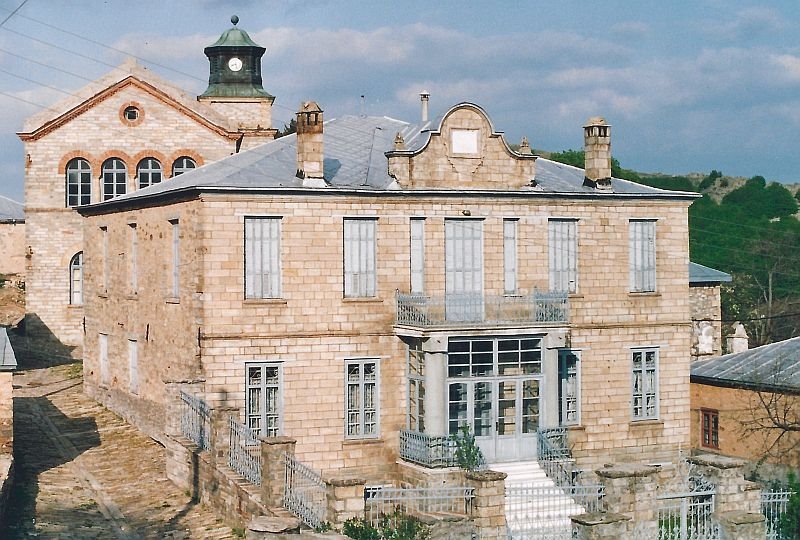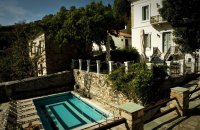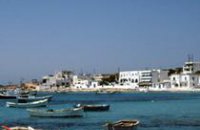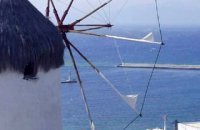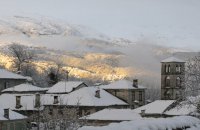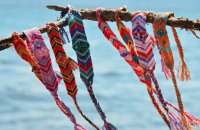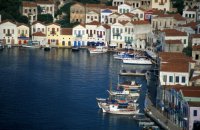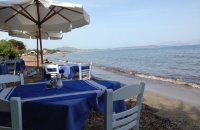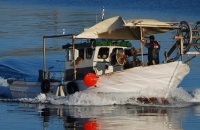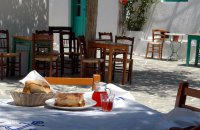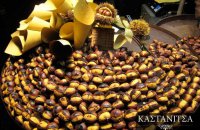Even if you have seen photos, nothing can prepare you for the surprise of actually being there. Its founders hid it so skillfully from prying eyes that the city offers no tantalizing glimpse from afar. Instead, you will ascend a seemingly interminable corkscrew of a road, practically straight up from the valley between Mt. Vermio and Mt. Verno, with the smokestacks of Ptolemaida belching in the distance and not a trace of habitation in sight. Even when you arrive at the gates of Nymphaio, there is only a large parking lot waiting to greet you. Beside it, there is the hotel-restaurant of Ta Linouria, an elegant grey-stone building enclosed by a green lawn, hinting at what is to come.
Unless you have booked one of Nymphaio’s six small pensions, you must leave your car behind and walk up the hill to the village proper, for most of Nymphaio’s streets are off limits to the motor vehicle. You will soon reach the main square, fronted by the Neveska hotel-restaurant and flanked by a café, a shop selling traditional local foods made by the Women’s Organization, and a grassy area where horses may be grazing. Though the horses of Nymphaio roam at will, unfettered, and unnoticed by the locals, visitors pursue them with their cameras.
Pleasant though it is, the square cannot compare to the houses surrounding it, each of which is a work of art, a poem written in stone. Rising above them all, Nymphaio’s largest building, the Nikeos School with its clock tower, looks as though it has been lifted out of Basle. A plethora of lovely villages abound in Greece’s mountains: the Zagorohoria in Epirus, Metsovo, Pelion – all of which were built by the master stone masons of so-called Mastorohoria in western Macedonia, north of Konitsa. But in none of these other places are the homes so impeccably cared for, the cobbled streets so litter-free, the gardens so lush, the atmosphere so, well, unGreek as it is in Nymphaio. With its tin-lined roofs designed to encourage the snow to slide off, this is the kind of village you might expect to find in Switzerland, Austria, Germany, or France, up in the Alps.
Nymphaio is all the more remarkable because, only twenty years ago, two-thirds of its houses lay in ruins; only sixty inhabitants, mostly elderly, eked out a living there. For almost six hundred years it had prospered, as its Vlach citizens were among the most dynamic people in the Hellenic world. Whether as the thrifty peddlers of meat, cheese, hides, and weavings that originally habited the village, or later as the talented jewelers, or finally as the Ottoman Empire’s tobacco and cotton tycoons, the villagers of Nymphaio possessed the Midas touch for centuries. They called their village, hidden but not immune to Turkish attacks, Niveasta, which in Vlach has three meanings: Nymph because of the sylvan setting; Invisible (Ni Vista) because of its unique location; and Snow-covered because of the mountainous climate (Nives Ska). It was renamed Nymphaio in 1928.
The lethal combination of World War II, the Greek Civil War, and the rapid process of urbanization crippled Nymphaio. It might have remained a ruined relic were it not for the determination of a few visionary native sons led by writer Nikos Mertzos and winemaker Yannis Boutaris, or as they dubbed themselves, “The Last of the Mohicans.” They energized the drive to restore collapsed buildings, repave the streets, and install vital public utilities.
But a pretty face is not enough to bring a village back to life, and Boutaris, with his experience in the wine industry, knew that Nymphaio needed to attract the new leisure class of weekenders in order to survive. With them in mind, he created a dream place called La Moara (Watermill in Vlach) just outside the village limits, close to the forest that cloaks the steep hills above it. Though it has only eight rooms, La Moara has acquired renown as one of the finest small hotels in this country. It was closed when I visited in early June, but luckier friends extoll its comfortable rooms, superb restaurant, and warm, welcoming staff. As it has its own stable, riding through the woods around Nymphaio is yet another of the many joys that come with staying there.
Frustratingly, La Moara is closed on Mondays and Tuesdays, but it can be substituted with another delightful option: Athina. Built in 1900, Athina was formerly a five-room house that has recently been converted into a charming traditional inn. Its owner, Yannis Papadopoulos, recommends that those who intend to stay at his inn book their fall and winter weekends far in advance.
But Nymphaio is not just a wonderfully executed reconstruction of a fascinating era. It is also a thriving town that is actively fighting for its two vanishing species. The Arcturos refuge for bears has almost nothing to do with renowned wine that shares its name, other than that it too owes its existence to the affluent Boutari family. From its headquarters in Thessaloniki, Arcturos set up a sanctuary for dancing bears just outside Nymphaio in 1993, and then another one for wolves at Agrapidia off the main road to Kastoria in 1998. The refuge also runs an environmental information center/veterinary clinic at Aetos, located between the two sanctuaries. Not all the farmers in the area support their efforts; some even accuse Arcturos of releasing their bears and wolves into the wild to savage their livestock.
So, when you go to Nymphaio, make a point of visiting and advocating these important refuges. It is not often you can lend Mother Nature a helping hand while indulging all your senses so magnificently.
How to get there:
Nymphaio lies 610 km north of Athens, west of Veria, east of Kastoria. The most direct route from Athens is via Larissa and Kozani; from Thessaloniki drive west through Yiannitsa and Edessa.
Where to stay:
There are six small pensions in Nymphaio, none larger than ten rooms. La Moara, 8 rooms, tel. 2310 287626; price includes breakfast and dinner; Ta Linouria, 10 rooms, tel. 23860 31133; Athina, 5 rooms, tel. 23860 31141. La Betlou (23860 41282, Enterne (23860 31230) and La Galba (23860 31314) are other, slightly more economical possibilities. La Moara has its own stables but the other pensions can also arrange for horses and guides if you’d like to ride.
Where to eat:
Besides Neveska and Ta Linouria, La Betlou has its own taverna, and the Archondiko serves traditional dishes, too. But for a special meal, try Thomas’s Taverna at Sklithrou, on the main road to Kastoria. It is known for miles around for its cava (liquor store), which lists almost 300 different Greek wines.
Greece: Nymphaio, A Town with the Midas Touch
Everything you’ve heard about Nymphaio is true; it really is the most beautiful village in northern Greece.
Country:
Category:















































